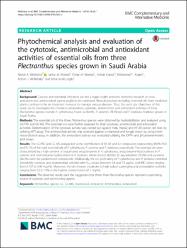Phytochemical analysis and evaluation of the cytotoxic, antimicrobial and antioxidant activities of essential oils from three Plectranthus species grown in Saudi Arabia

View/
Access
info:eu-repo/semantics/openAccessDate
2018Author
Mothana, Ramzi A.Khaled, Jamal M.
Noman, Omar M.
Kumar, Ashok
Alajmi, Mohamed F.
Al-Rehaily, Adnan J.
Kürkçüoğlu, Mine
Metadata
Show full item recordAbstract
Background: Cancers and microbial infections are still a major health problem, therefore research on new anticancer and antimicrobial agents ought to be continued. Natural products including essential oils from medicinal plants continue to be an important resource to manage various diseases. Thus, the particular objectives of this study are to investigate the chemical composition, cytotoxic, antimicrobial and antioxidant activities of three Plectranthus species namely P. cylindraceus Hocst. ex Benth., P. asirensis JRI Wood and P. barbatus Andrews grown in Saudi Arabia. Methods: The essential oils of the three Plectranthus species were obtained by hydrodistllation and analyzed using GC/FID and GC-MS. The essential oils were further assessed for their cytotoxic, antimicrobial and antioxidant activities. Determination of the cytotoxic activity was carried out against Hela, HepG2 and HT-29 cancer cell lines by utilizing MTT-assay. The antimicrobial activity was assessed against six bacterial and fungal strains by using broth micro-dilution assay. In addition, the antioxidant activity was evaluated utilizing the DPPH and beta-Carotene-linoleic acid assays. Results: The GC/FID and GC-MS analysis led to the identification of 59, 60 and 42 compounds representing 89.0% 95.0 and 97.1% of the total essential oils of P. cylindraceus, P. asirensis and P. barbatus, respectively. The essential oils were characterized by a high content of oxygenated sesquiterpenes in P. cylindraceus, sesquiterpene hydrocarbons in P. asirensis and monoterpene hydrocarbons in P. barbatus where maaliol (42.8%), beta-caryophyllene (13.3%) and alpha-pinene, (46.2%) were the predominant compounds. Additionally, the oils particularly of P. cylindraceus and P. barbatus exhibited remarkable cytotoxic and antimicrobial activities with IC50-values between 3.8 and 7.5 mu g/mL and MIC-values ranging from 0.137 to 4.40 mg/mL. Moreover, the oils showed moderate to high radical scavenging and antioxidative activities ranging from 52 to 75% at the highest concentration of 1 mg/mL. Conclusions: The observed results back the suggestion that these three Plectranthus species represent a promising source of cytotoxic and antimicrobial agents.

















